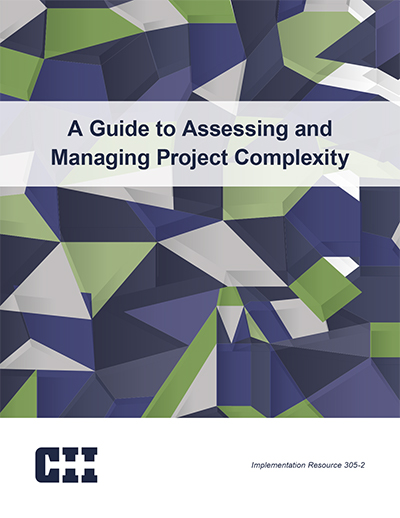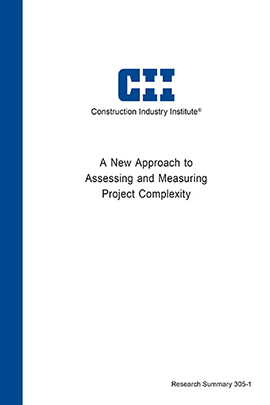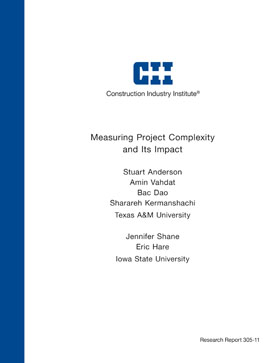
A Guide to Assessing and Managing Project Complexity
“Complexity” is used as a catch-all term throughout the construction industry. Whenever complexity is poorly understood and managed, project failure and uncertainty follow. Through a structured research process, CII Research Team 305 (RT-305) identified 37 indicators of project complexity and built them into a Project Complexity Assessment and Management (PCAM) Process. By completing this process, project teams can increase their likelihood of achieving predictable project outcomes and project success.
The definition of project complexity varies greatly from person to person and project to project. Each project team needs to develop a common understanding of the complexity of its specific project before it can begin to understand and manage the challenges that complexity can bring to the project process. RT-305 formed a working definition of complexity based on the management of a project, to allow teams to assess what contributes to project complexity, how to measure that complexity, and to identify strategies to manage complexity.
“Project complexity is the degree of interrelatedness between project attributes and interfaces, and their consequential impact on predictability and functionality.”
After developing its definition of complexity, RT-305 identified 40 attributes of complexity by drawing on a review of literature (both about complexity and complexity theory) and team members’ personal experience. The team divided the attributes into 11 categories:
- Stakeholder management
- Governance
- Legal
- Fiscal planning
- Interfaces
- Scope definition
- Location
- Design and technology
- Project resources
- Quality
- Execution targets
RT-305 developed a survey to explore each attribute in greater depth, then deployed the survey to CII membership companies. Responses included a mixture of high- and low-complexity projects. Based on a statistical analysis of the questions, answers differed between high- and low-complexity projects for 23 attributes. The questions with observed differences were developed into 37 complexity indicators.
During the second phase of the project, a survey was developed that explored each of the attributes in greater depth. The survey was deployed to CII membership companies. Responses included a mixture of high a low complexity projects. Based on a statistical analysis of the questions there was a difference in answers between high and low complexity projects for 23 attributes. The questions with observed differences were developed into complexity indicators, thus addressing the first research hypothesis.
An analysis of two sets of data were used to address the second research hypothesis. There is a relationship between the complexity indicators and project performance. The first set of data from the CII Benchmarking and Metrics, which includes one question on project complexity, demonstrated no relationship between complexity and performance. The data analysis on the RT-305 complexity indicators found that there are three indicators with a relationship to cost performance and one indicator with a relationship to schedule performance.
Armed with these complexity indicators, RT-305 developed the Project Complexity Assessment and Management (PCAM) Process, which includes the following three steps:
Step 1 – Project Complexity Attribute and Indicator Identification
Step 2 – Project Complexity Assessment and Management (PCAM) Tool Application
Step 3 – Project Complexity Strategies to Manage Key Project Complexity Indicators
The PCAM Process is intended to be completed by a project team at least once during project development; however, multiple applications may be beneficial to assess the changing complexity typical for a complex project. Each iteration of the PCAM Process builds a team understanding of the complexity of the project, a graphical representation of the level of impact of the complexity indicators, and a list of strategies to help manage the contributing complexity indicators.
RT-305 developed the Project Complexity Assessment and Management (PCAM) Tool as part of its work. The PCAM Tool is an Excel-based spreadsheet that provides a user-friendly instrument to help project teams assess and manage a variety of complexity attributes.
Each of the 37 indicators associated with the 23 attributes are used to score the indicator’s contribution to the project complexity profile. A project team can use the PCAM Tool to assess the current level of project complexity at any particular point or phase in the project life-cycle. The details of the PCAM Tool use can be found in the implementation resource (IR 305-2). The PCAM Tool also graphically displays indicators to show where a project team should focus their attention to manage a project specific set of complexity attributes to control the drivers of complexity. The value of the research is a tool with outputs that helps less experienced project teams identify blind spots and implement strategies to deal with project complexity. Figure 9 illustrates an example of graphical outputs of the PCAM Tool.
The PCAM process includes three steps:
Step 1 – Project Complexity Attribute Selector (PCAS) Tool
Step 2 – Project Complexity Assessment and Management (PCAM) Tool Application
Step 3 – Project Complexity Strategies to Manage Key Project Complexity Indicators
The high-level purpose of the PCAM process and tool is to identify key project complexity indicators, assess their potential impacts on a project, and design a plan to manage the potential impacts of the complexity indicators. The PCAM process and tool are designed to be flexible enough to deploy in many different ways and at multiple stages of project development and delivery. RT-305 divided the recommended PCAM process uses into four categories and identified the CII project phases in which these categories may belong. The project timeline shown in Figure 13 indicates possible uses of the process relative to the CII Front End Planning (FEP) and Project Execution gates with the following categories and phases as reference points.



